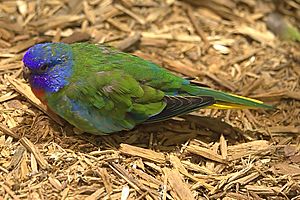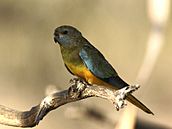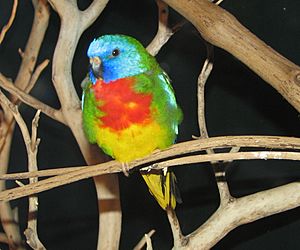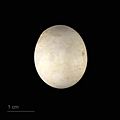Scarlet-chested parrot facts for kids
Quick facts for kids Scarlet-chested parrot |
|
|---|---|
 |
|
| Taken at the Cincinnati Zoo | |
| Conservation status | |
| Scientific classification | |
| Genus: |
Neophema
|
| Species: |
splendida
|
The scarlet-chested parrot (Neophema splendida) is a beautiful, colorful bird found only in parts of South Australia and Western Australia. People also call it the scarlet-breasted parrot or splendid parrot. These parrots are special because the males and females look different. Males have bright blue faces and a scarlet red chest. Females are mostly green with a blue face.
These parrots are nomads, meaning they move around a lot. They travel from the Great Victoria Desert to other areas. They do this to find better places to live and more food. Scarlet-chested parrots can live without much drinking water. They get most of their water from juicy plants. They mostly eat grass seeds and are often seen in areas with spinifex grass.
Contents
About the Scarlet-Chested Parrot
The scarlet-chested parrot was first described by a famous bird expert and artist. His name was John Gould, and he named it in 1841. He called it Euphema splendida, using the Latin word "splendida" which means "splendid" or "magnificent".
Later, in 1891, an Italian bird expert named Tommaso Salvadori created a new group of birds. He called this group Neophema. He then placed the scarlet-chested parrot into this new group. This is how it got its current scientific name, Neophema splendida.
The scarlet-chested parrot is one of six types of "grass parrots" in the Neophema group. It is very closely related to the turquoise parrot. These two parrots are the only ones in their group where males and females look very different.
What Do Scarlet-Chested Parrots Look Like?
These small, bright parrots are about 19 to 21 centimeters (about 8 inches) long. The male and female parrots look quite different.
The male parrot is very colorful. He has a bright red chest and a shiny blue face. His upper body is bright green. His lower chest and belly are yellow. The feathers on his wings are light blue. His tail is green, and his eyes are brown. He has a blackish beak and brownish-grey legs.
The female parrot also has a blue face, but it is not as bright or widespread as the male's. Her upper body is green, and her chest is also green. Her belly is yellow. Young parrots look like duller versions of their parents. Young males start to get red feathers on their chest when they are a few months old. Their red chest becomes fully colored when they are about 15 to 18 months old.
The female scarlet-chested parrot looks a bit like the female turquoise parrot. However, you can tell them apart by the blue area around their eyes and a lighter blue patch on their wings. The call of the scarlet-chested parrot is a soft, quiet twittering sound.
Where Do Scarlet-Chested Parrots Live?
Scarlet-chested parrots live in dry areas across southern Australia. You can find them from places like Pingelly and Laverton in Western Australia. They also live east through South Australia and into the southern Northern Territory. Sometimes, they are seen in far western New South Wales.
In New South Wales, these parrots are considered "vulnerable." This means their numbers are decreasing. Some dangers they face include trees being cut down. They need large trees with hollows for their nests. Another danger is people trapping them to keep as pets. Also, farm animals and wild animals eating too much grass can harm their food supply.
These parrots live in dry areas with Eucalyptus and Acacia trees. They also live in grasslands that have plants like Atriplex and Triodia. It is hard to know exactly how many of these birds there are. Even though they are brightly colored, they are shy and can be hard to spot.
What Do Scarlet-Chested Parrots Eat?
Scarlet-chested parrots mainly eat seeds from different types of grasses. They are also thought to eat juicy plants like Calandrinia. These plants help them get enough water, especially in dry areas.
Reproduction and Life Cycle
Scarlet-chested parrots usually breed between August and October. They might also breed after it rains. They can have one or sometimes two groups of babies, depending on how much rain there has been.
They make their nests in hollows inside small trees. These are often mulga or eucalypt trees. The female lays four to six round, white eggs. Each egg is about 23 by 19 millimeters in size.
Scarlet-Chested Parrots as Pets
Scarlet-chested parrots are becoming more popular as pets. They are one of the most liked types of Neophema parrots kept by people. Their calm nature and small size make them good birds for aviaries (large bird cages).
There are many different color variations of these parrots. These are called "mutations." Some common ones include red-fronted, par blue, and cinnamon. Even though they have many color types, they can sometimes be a bit delicate and not live as long as other parrots. They can also get a type of infection called Candida when kept as pets.
To help prevent Candida infections, it is important to feed them the right diet. It's best to avoid foods that encourage fungus growth, like refined flour and sugary fruits. Adding natural anti-fungal foods can help. Fresh crushed garlic and herbs like oregano, thyme, and rosemary are good choices. With good care and a natural diet, scarlet-chested parrots can be healthy and live a long time.
Images for kids
See also
 In Spanish: Periquito espléndido para niños
In Spanish: Periquito espléndido para niños






